At last, an Update!
It’s been a long time since my last update. During the winter I became ill and I ended up being unable to do any butterflying until the start of December, which was very frustrating as a number of my favourite species are on the wing in the Spring but I couldn’t go to look for them.
I finally made it out to the Blue Mountains on 1st December, to meet up with Scottish couple Colin & Joan and (hopefully) see some interesting butterflies. We started by going to a couple of hilltops at Bell, where we unfortunately didn’t see any Golden Ant-blues (Acrodipsas aurata) though eventually a Bronze Ant-blue (A. brisbanensis) turned up. He mostly settled at the top of the tallest eucalypt on the hilltop; which isn’t very high up but far enough to prevent us from getting any decent photos. After we repeatedly shook the eucalypt he deigned to settle on a low shrub for long enough to allow a couple of photos.
There weren’t all that many butterflies to be seen, though they did include several new species for Colin and Joan. During the afternoon we moved onto Blackheath but by the time we got there the clouds had closed in and the wind had strengthened; it had become rather cool and almost nothing was flying. We therefore made the best of it and went to the pub for a couple of beers.
The following weekend we tried again, though this time we started by going to Clarence to look for the Montane Iris-skipper (Mesodina aeluropis). This site is true skipper country and at times there can be several interesting species to be seen there. This day was one of the exceptions; we trudged around for a while before we managed to find a single skipper, which turned out to be an aeluropis so the first target for the day was ticked.
At Bell we again missed out on aurata, so we again went on to Blackheath. It was sunny this time and we made several quick stops finding a new species for Colin and Joan at each of them. Our last site for the day was the hilltop where we were hoping to see the Moonlight Jewel, a.k.a Blue Jewel (Hypochrysops delicia), which I think was the species C&J were most keen to see. Late in the afternoon we were treated by the appearance of two of these lovely butterflies, one of which was a pristine fresh specimen. As usual they would appear out of nowhere, circle the hilltop a couple of times at high speed whilst dogfighting with any other hilltopping butterflies they could find, and then disappear for half an hour or so. But our patience was rewarded as they did settle a couple of times to pose for photos, though the strong breeze made it very difficult to get decent shots. The delicia were the last butterflies we saw that day, as low cloud swept in and cloaked the whole of Blackheath in fog. We again adjourned to the pub, though this time in a more celebratory mood.
I took very few photos on those two days, but they did show that I was able to out and about again provided I took things easy and didn’t overdo it.
My next trip was to Georges Hall in suburban Sydney, to a bushland reserve that’s home to a colony of Imperial Hairstreaks (Jalmenus evagoras). This was a day when a plan really paid off. In my early days of butterfly photography, back in early April 2004, I took my first photos of evagoras. I was using a little point-and-shoot digital camera back then, and I was not taking shots at the highest resolution owing to a rather stupid preference for being able to store more images on the memory card. On that day I had some evagoras pose beautifully with their wings spread flat, sitting on low plants to allow me to get the ideal angle.
In the 20 years since then I had photographed a large number of evagoras but they had never posed so well for me. This day, 22nd December, started cool with a heavy overcast and almost no wind, though the forecast predicted it would become warmer, brighter and breezier during the day. I reckoned that if I got to Georges Hall before the evagoras got warmed up I might have the chance of getting them while they were opening their wings wide so as to maximise the UV they could absorb. For once a plan of mine actually worked. One individual was particularly cooperative, sitting in a perfect pose for several minutes while I just kept on taking shot after shot. By lunchtime it had become warm and windy, and the butterflies had become way too frisky, so I put my camera away and went home.
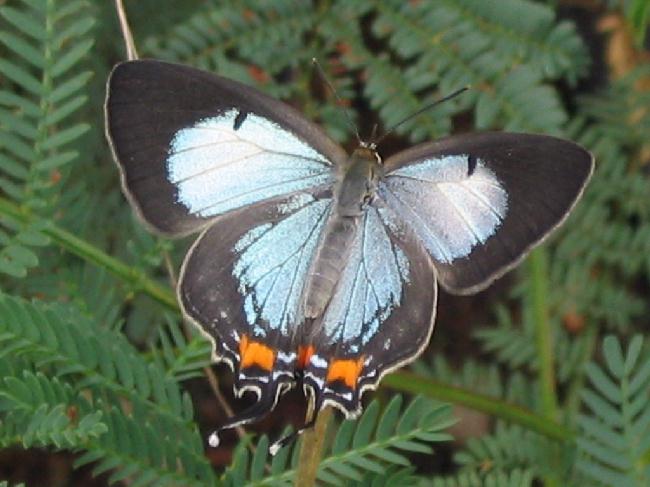
Jalmenus evagoras

Jalmenus evagoras
After a couple of fairly unproductive days at Bell and Lawson, my next trip of note was when I went to Blackheath with Kai. Our main target was delicia, but on the way we found some very nice skippers nectaring from flowers. I was particularly pleased to get shots of a lovely female Large Brown Skipper (Hesperilla trimaculata). I haven’t seen all that many female trimaculata, though I’ve come across loads of hilltopping males, and this one was a great specimen.
We did see a delicia later in the afternoon, but he was not in good condition and he only settled once or twice and only very briefly.


In early February 2024 I went to the ACT with Nils of Australian Butterfly Conservation, in search of the elusive Yellow Jewel (Hypochrysops byzos). We did find one, or to be more accurate we found the wreck of one, it being just about the tattiest butterfly I’ve ever seen that wasn’t actually dead.
We decided to try again, this time over the Australia Day long weekend, it being slightly earlier in the season and therefore the byzos ought to be in better condition. We spent ages searching but didn’t see any byzos, not even an ancient tatty specimen. There were some consolations as we were able to get close-up shots of a stunning female Imperial Jezebel (Delias harpalyce), but overall the trip was disappointing. That’s butterflying for you…
The following weekend we spent a day out at the Kanagra-Boyd National Park. Here we found approximately a million Barred Skippers (Dispar compacta) and nearly as many Bright Shield-skippers (Timoconia flammeata). I was more interested in the Two-brand Grass-skippers (Atkinsia dominula); although most of them were rather worn and faded there were some fresh ones around and they were very colourful. I also photographed some Two-spotted Grass-skippers (Pasma tasmanica); this had been one of my top targets for the day as most of my shots of this species were taken back in the days when I was using the old point-and-shoot camera.
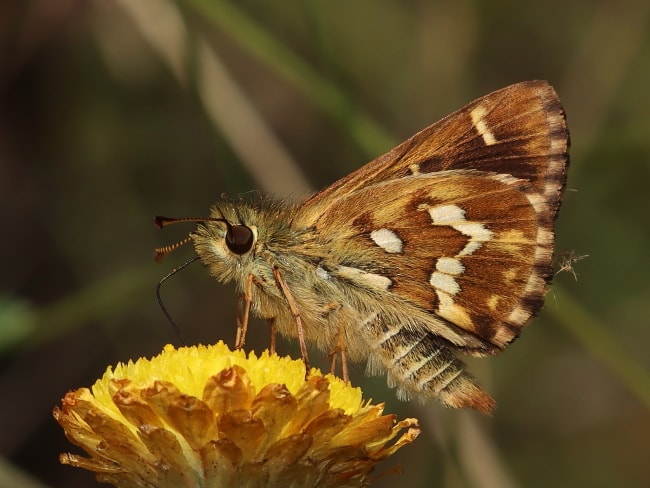
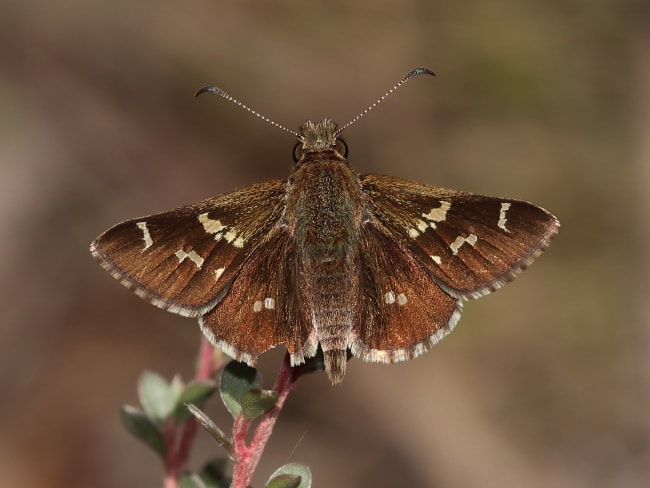
One of the real highlights of the day came when we had turned around to head back to Sydney. We were still in the National Park when we came to an area where there were large stands of everlasting daisies along both sides of the road. These flowers were swarming with hungry butterflies. They were mostly common species, particularly Common Browns (Heteronympha merope) and Yellow Admirals (Vanessa itea), but it was a brilliant sight to see so many of them.
I needed more shots of itea, which is usually a difficult subject, so I got busy with my camera. Before long several Macleay’s Swallowtails (Graphium macleayanum) showed up; these butterflies are normally skittish and wary but they were so intent on nectaring from the daisies that they didn’t care about me sticking my camera right into their faces.
I ended up taking 436 butterfly photos that day. A higher proportion than usual were rejects, mainly because of the breezy conditions, but it certainly was a productive day!

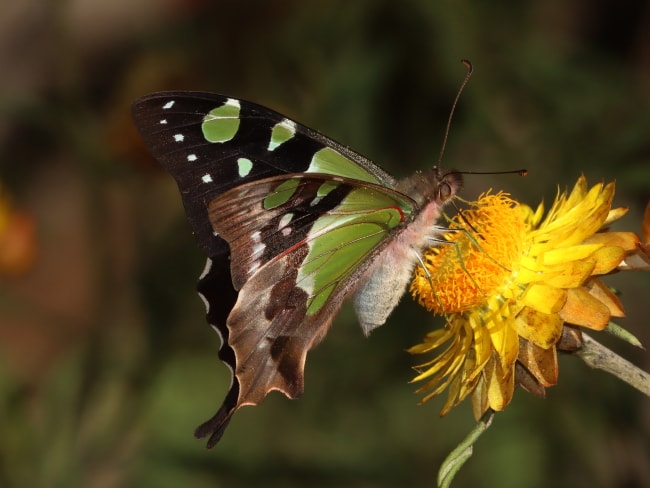
Nils was still staying in the Sydney area, so the following weekend we went up to the Barrington Tops National Park, a place I’d only visited once before. We had two days to get shots of the local subspecies of Swordgrass Brown, namely Tisiphone abeona regalis, which looks very different to the version I’m used to seeing around Sydney and the Blue Mountains.
We found our first one just after noon on the Saturday; it was a lovely female and she was surprisingly cooperative. She pottered around her Gahnia host plants and obligingly posed with her wings open, then closed. Nils and I both took a number of photos until she decided to move on. We saw several more regalis that day, though they were all rather worn and not so well behaved.
Most of the butterflies we saw were species we’d also seen recently in the ACT and/or Kanagra-Boyd, though a highlight for me was a very colourful female Shouldered Brown (Heteronympa penelope); I’ve mostly seen males of this species.
On the Sunday we started off by getting photos of Chequered Grass-skippers (Anisynta tillyardi), a very pretty skipper that I’d only seen on two prior occasions. We then went in search of more regalis. This time the first one we found was a rather faded female, which also cooperated with us and allowed plenty of photos to be taken. The next one we saw was an absolute stunner. Occasionally you see a specimen that is so fresh and colourful that they almost appear to glow, especially if the light is good, and she was one of those special butterflies. The photos really don’t do her justice, in fact it appears that whoever said “the camera doesn’t lie” might have been fibbing because my photos of her really don’t look much different to the first regalis we’d found the day before. More likely the fault lies with the photographer rather than with the camera…
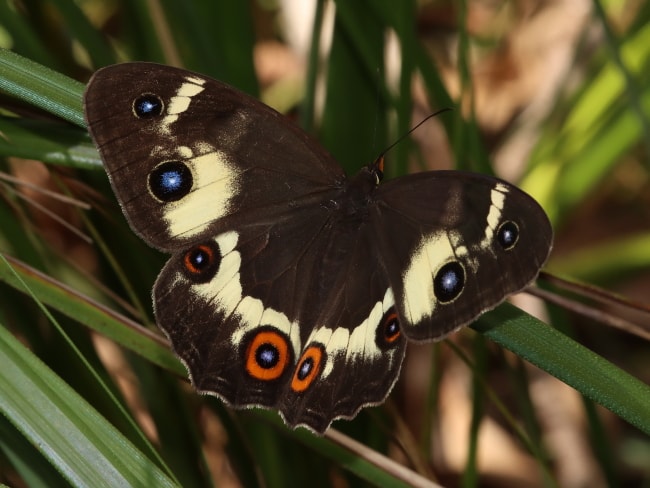
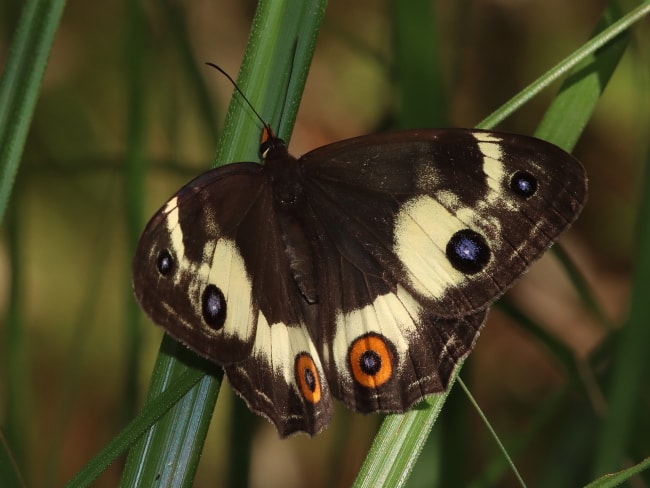
Sunday’s butterflying ended the same way that Saturday’s had, with Nils and I unsuccessfully searching for Alpine Sedge-skippers (Hesperilla munionga) amongst the Carex growing in the Polblue Swamp. The weather closed in and we started hearing some thunder, so we gave up and headed back to Sydney
Photo Gallery Updates
I have added photos to the following species pages:- Acraea andromacha (Glasswing)
- Vanessa itea (Yellow Admiral)
- Tisiphone abeona regalis (Swordgrass Brown, Barrington Tops subspecies)
- Oreixenica lathoniella (Silver Xenica)
- Heteronympha merope (Common Brown)
- Heteronympha penelope (Shouldered Brown)
- Heteronympha cordace (Bright-eyed Brown)
- Geitoneura acantha (Ringed Xenica)
- Geitoneura klugii (Marbled Xenica)
- Paralucia pyrodiscus (Fiery Copper)
- Jalmenus evagoras (Imperial Hairstreak)
- Jalmenus ictinus (Stencilled Hairstreak)
- Erina hyacinthina (Varied Dusky Blue)
- Erina acasta (Blotched Blue)
- Candalides heathi (Rayed Blue)
- Nacaduba biocellata (Two-spotted Line-blue)
- Leptotes plinius (Plumbago Blue)
- Zizina otis (Common Grass-blue)
- Trapezites phigalioides (Montane Ochre)
- Trapezites praxedes (Southern Silver Ochre)
- Trapezites symmomus (Splendid Ochre)
- Anisynta tillyardi (Chequered Grass-skipper)
- Atkinsia dominula (Two-brand Grass-skipper)
- Pasma tasmanica (Two-spotted Grass-skipper)
- Dispar compacta (Barred Skipper)
- Timoconia flammeata (Bright Shield-skipper)
- Hesperilla trimaculata (Large Brown Skipper)
- Ocybadistes walkeri (Green Grass-dart)
Contacts page
Whilst working on the November 2023 update I tested out my Contacts page and found that my email form is no longer working. I don’t know why it broke or when it happened, so if you’ve tried contacting me that way and received no reply, please accept my apologies.
I had a go at fixing it but didn’t get it working. In the meantime I’ve replaced the form with links to my Facebook and Instagram, as it should be possible to contact me that way instead.
